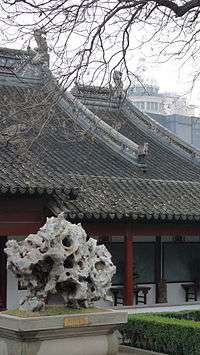Chinese scholar's rocks

Chinese scholars' rocks (Chinese: 供石; pinyin: gōngshí), also known as scholar stones or viewing stones, are naturally occurring or shaped rocks which are traditionally appreciated by Chinese scholars.[1]
Scholars rocks can be any color, and contrasting colors are not uncommon. The size of the stone can also be quite varied: scholars rocks can weigh either hundreds of pounds or less than one pound.[2] The term also identifies stones which are placed in traditional Chinese gardens.
History
In the Tang dynasty, a set of four important qualities for the rocks were recognized. They are: thinness (shou), openness (tou), perforations (lou), and wrinkling (zhou).[1]
Chinese scholar's rocks influenced the development of Korean suseok and Japanese suiseki.[3]
Origin
The origin of the stone is a notable feature.

- Lingbi stone (Lingbishi) from Lingbi, Anhui province, limestone[4][5]
- Taihu stone (Taihushi) from Lake Tai, Jiangsu province, limestone[4]
- Yingde stone (Yingshi or Yingdeshi) from Yingde, Guangdong province, limestone[6]
Aesthetics
The aesthetics of a scholar's rock is based on subtleties of color, shape, markings, surface, and sound. Prized qualities include:
- awkward or overhanging asymmetry[7]
- resonance or ringing when struck[7]
- representation or resemblance to mountainous landscapes or figure[7][8]
- texture[7]
- moistness or glossy surface[7]

The stone may be displayed on a rosewood pedestal that has been carved specifically for the stone. The stones are a traditional subject of Chinese paintings.[9]
See also
References
- 1 2 Metropolitan Museum of Art, "The World of Scholars' Rocks Gardens, Studios, and Paintings"; retrieved 2012-12-20.
- ↑ Harvard Shanghai Center, "Scholar Stone"; retrieved 2012-12-20.
- ↑ Brokaw, Charles. (2011). The Temple Mount Code, p. 73.
- 1 2 Cousins, Craig. (2006). Bonsai Master Class, p. 246.
- ↑ Lingbi Stone and Asian Art Collection. (2014)
- ↑ Cousins, p. 247.
- 1 2 3 4 5 Mendelson, John. "Chinese scholars' rocks simultaneously original and simulacrum" at ArtNet.com, 1996; retrieved 2012-12-20>
- ↑ Smith, Roberta (1996-05-31). "ART REVIEW;Old Chinese Rocks: Rorschach Blots In 3 Dimensions". New York Times. Retrieved 2014-07-10.
- ↑ Harvard Museums, "Scholar's rock", 1993 painting; Linrothe, Robert N. (2004). Paradise and Plumage: Chinese Connections in Tibetan Arhat Painting, p. 24; retrieved 2012-12-20.
Further reading
- Little, Stephen, Spirit stones of China, the Ian and Susan Wilson collection of Chinese stones, paintings, and related scholars' objects, Chicago, Art Institute of Chicago, 1999, ISBN 0-86559-173-3
External links
![]() Media related to Scholar's rocks at Wikimedia Commons
Media related to Scholar's rocks at Wikimedia Commons
- Visuals and examples of scholar rocks
- Galleries of scholar rocks
- Books on scholars' rocks
- Chinese scholar's rock history, an introductory historical background
- Classification of Chinese scholar's rocks
- Scholar's rock at Metropolitan Museum of Art